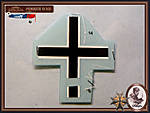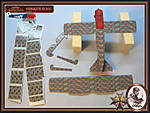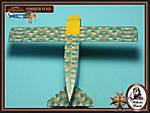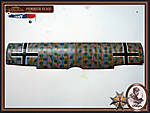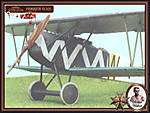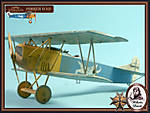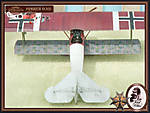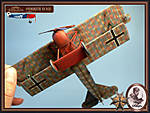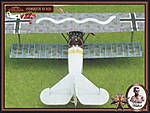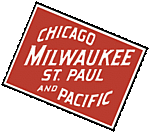1⁄35Fokker D.VII Royal Class
14
Comments
decals
OAW types...Pages 16 - 17. In August 1918 when their new Fokker E.V types were grounded due to a series of inflight failures, Jasta 6 were assigned a complement of Fokker D.VII (OAW) types from a small portion of the mid production batch machines from D. 4500 - 4549/18. These aircraft were given the unit’s black and white stripes on the engine cowling, tail and wheel covers. Coming from Jastaschule I, Ltn. Fritz Schliewen was photographed in this aircraft after he reached the unit on 15 August. He was to gain two victories with Jasta 6. The crosses on the lower wings need to be either centered on the fourth rib or with the horizontal arm overlapping the wing tip rib. Note to do the aircraft scheme suggested you will have to cut off some of the forward most vent cups on both the left and right fuselage sides. Check your references.
Pages 18 - 19. The command of Jasta 19 was given to Ltn. des Res. Wilhelm Leusch on 18 October 1918. He led Jasta 19 until the end of the war, while the unit was based in Trier. Leusch personalized his aircraft from the D.6300 to 6649/18 production batch with beautifully depicted dragon. The typical paint scheme of Jasta 19 markings, was the yellow nose, blue rear fuselage (the blue was the Jagdgeschwader II marking). This machine was later photographed in French hands post war.
Pages 20 - 21. The Jasta 37 unit marking was black and white striped angled across the horizontal tail, as this unknown pilots aircraft probably from the D.6300 to 6649/18 production batch illustrates. It is also known that some of the Jasta 37 pilots had the noses of their Fokker D.VII types painted an individual colour and block letters or bands on the fuselage. This is one turned in British hands at Nivelle, Belgium at the war’s end. The quality of this image is such that it could have been either 4 or 5 colour it is just very tough to tell. Pages 22 - 23. On September 14th, German fighters shot down 58 enemy aircraft and balloons, while they paid with two wounded and two captured pilots. One of these was Ltn. Paul Wolff a Jasta 13 novice, who was forced to land Lake Lachaussé at 15.10 hours. Later this machine (from the D.6300 to 6649/18 batch) was photographed on the AEF airfield at Colombey les Belles.
Fokker Schwerin types...
Pages 24 - 25. The first unit to receive the new Fokker D.VII in late April/early May, 1918, was Jasta 10 of the elite Jagdgeschwader I. Ltn. Friedrich Friedrichs came to Jasta 10 on 11 January, 1918 from FAA 264. Here, he achieved his first aerial victory in March, increasing his combat score to 21, including 11 balloons. The destruction of observation balloons would become his specialty. On a hot 15 July, when the ammunition storage box exploded in his Fokker, Friedrichs jumped free from the aircraft, but his parachute snagged the tail unit. The parachute was torn off the harness. Ltn. Friedrichs was killed over Arcy at 20.45 hours in Fokker D.VII 309/18. The lower wing crosses should be further inboard by one rib space.
Pages 26 - 27. Jasta 2 ’Boelcke‘ was, with a tally of 336 victories, the second most successful unit of the German air force during the First World War. Hauptmann Carl Bolle commanded the unit in 1918 at a time when the Fokker D.VII made up most of the fighter inventory. Hauptmann (Captain) Bolle led the Jasta in exemplary fashion and gained 31 of his 36 victories, sixteen of them on the Fokker D.VII. One of his currently unknown subordinates flew this early production Fokker D.VII 332/18. The lower wing crosses should be further inboard by one rib space. Untypically this early machine’s wings were covered in 5 colour lozenge.
Pages 28 - 29. In the past this aircraft is thought to have been assigned only to Ltn. Hugo Schaefer of Jasta 15 (a unit of Jagdgeschwader II), note the nose color is shown in Jasta 15s red. Hugo Schaefer gained a total of 11 aerial victories while serving with Jasta 15. He was shot down by an SE-5 (probably 24 Squadron, RAF) in July, 1918, but safely landed with a seized engine on the German side. The latest research shows the aircraft was most probably passed on to Jasta 19 another Jagdgeschwader II unit. The red nose was over painted with Jasta's 19 yellow. It is believed the aircraft was captured with this marking on 27 October, 1918, when Capt. E. V. Rickenbacker of the 94th Aero shot down Ltn. des Res. Max Kliefoth. Thought to be covered in 5 colour lozenge and to be from the last part of the first production batch D.403 - 526/18. The cowling panels appear to be types seen on the later portion of the first production batch. You could actually take the "late" model Fokker fuselage and carve off some oif the appropriate louvres on each side and Voilà!
Pages 30 - 31. After the Armistice, Jasta Boelcke was ordered to pass its Fokker D.VII types on to the British at Nivelles. This unknown pilots aircraft was among such committed aircraft. A photo of the aircraft with RAF members was taken there. Often block letters on the sides of aircraft identified the pilot’s surname or the first letter in the name of a female friend. The lower wing crosses should be further inboard by one rib space. Thought to be in four colour fabric and could be from either batch number, D.5050-5149/18 or D.7604 - 7805/18.
Albatros, Johannistahl...
Pages 32 - 33. While flying Fokker D.VII types, Jasta 46 was commanded by Ltn Otto Creutzmann (8 victories) as a part of Jagdgruppe 2. The pilot of this aircraft is unknown but it was photographed in British hands post war. The lower wing crosses should be further out by one half of a rib space. There is evidence that the unit may have had red or black forward fuselages. The top wing is in 5 colour lozenge while the bottom wing is in four colour. When you work with models like this and you follow the directions without some other references you can get in trouble. Eduard recommends the early fuselage for the following scheme. But here is what you need to know about the problems you will face. Remember folks you saw it here first. Eduard implied in their artwork, but they did not include it in their instructions. To do this scheme / profile as photo-evidence provides:
A - Instead of using the early production fuselage you could use the late production and cut off select louvres and add the photoetch metal louvres to match the profile. ( Also don't forget that even though Eduard shows the capped exhaust port - in the known images you can not see this. A new side panel may have been fabricated in the field) or...
B - If you use the early production fuselage you have to cap off the the side exhaust exit and carve out the rim on the upper cowling to allow for the high exit exhaust . Then add the Eduard photoetch louvres.
Anthology 2 has some very interesting images of this bird in British captivity (with 84 RAF 1918 -1919). The altered side panels are a strong indication that this early Albatros built Fokker D.VII had not only both of the side and one upper panel altered BUT had its exhaust changed out from the "early side exit " type to the "later high exit" type. There is not enough evidence to prove that the engine was changed out and exhausts were a fairly common item. The engine we do see present is a Mercedes 180hp D.IIIaü type.
The next question is why? For those of you are less familar with the story, The hot summer months of 1918 manifested a problem with early Fokker D.VII types. (See the paragraph describing the death Ltn Friedrichs of Jasta 10). Heat build up in the engine compartment and the lack of venting led to the premature cook off of the ammunition stores - inflight. This concerned especially the phosporous capped tracer rounds. The answer was better air induction to, and venting from, the engine compartment. The early bird in question was probably at the front and the ground crew may have used this airframe to see what they could do in the field to overcome this problem. The easy answer in many instances was that the upper cowling panels were simply removed in the summer months. But it had to be a sacrifice in performance as it took away from the design characteristics of the machine to do this.
On the Jasta 46 machine the white zig-zag fuselage stripes are a bit oversized by about 1/4 of an inch. Cutting them at the apex of two of the spikes will allow you to better fit the sections on the fuselage. Taking this approach you will note also that the white zig-zag fuselage stripes are also a bit translucent. I touched them up with thinned flat white enamel. The yellow fuselage band is not included in the sheet so be prepared to manufacture your own. The “white worm” decal for the top wing goes down in good shape. But keep it wet on the paper backing until its positioned and then slide it off carefully.
Pages 34 - 35. In June 1918, Jasta 43 had a mixture of Fokker D.VII and Albatros D.V & D.va types. In an attempt to consolidate the equipment into one type, when Jasta 18 moved from the 6th to the 19th Armee area, their older Fokker D.VII (Alb.) types were supplied to Jasta 46. These aircraft bear the original Jasta 18 markings, including the raven on the fuselage. This aircraft depicted as being from the D. 528 - 926/18 production batch was flown by Leutnant der Reserve (Ltn des Res.) Josef Keller. He joined Jasta 43 on 5 June, 1918. His only victory came on 8 August 1918 when he brought down an SE5a near Bray-sur-Somme. His combat career ended on October 11, 1918, he was seriously wounded when he crashed during the test flight of a Jasta 43 Fokker D.VII.
The stripes for the Jasta 43 machine of Ltn Keller are a bit thin in the clear area between the red stripes and care should be exercised when applying these two sections ( for the left and right side). Always use warm water and keep the decal on the paper backing until ready to slide it off into place on the model. Carefully spread the decal out to the right location. Do one side at a time and using set first then sol and you will have very good results.
Pages 36 - 37. Vzfw Oskar Hennrich joined Jasta 46 on 6 May, 1918, after seven months service as a pilot of two seat types with FAA 273. He shot down a balloon as early as 14 May, and he reached 19 victories by October 1, 1918. Shooting down 13 observation balloons, he became the fourth most successful balloon buster in the Fliegertruppe during WWI. This machine is depicted as coming from the D. 6650 - 6899/18 production batch. The lower wing is an OAW replacement (4 colour lozenge with light blue rib tapes?) and the machine was powered by a BMW IIIa. The applications to Hennrich’s machine are fairly straight forward.
Pages 38 - 39. Oberleutnant Robert Ritter von Greim reached his first aerial victory in October while serving as an observer with FA 3b. He graduated as a pilot after the normal training course, serving with FA 46b. In April 1917, he joined Bavarian affiliated Jasta 34b, and became the unit commander in June, 1917. He led this unit until end of the war, with brief periods where he commanded the temporary groupings of frontline units called Jagdgruppe. These were Jagdgruppe 9 and Jagdgruppe 10 (Jasta 34b was a part of these temporary groupings, which were similar to a wing). Von Greim claimed a total 28 victories and he was awarded the “Pour le Mérite" on 8 October, 1918. This machine is depicted as coming from D.6650 - 6899/18, (probably before D.6746/18) in four colour fabric. He continued with his aerial career after WWI, as a consultant to the Chinese Air Force. Later, in the mid thirties, he led Jagdgeschwader Richthofen. His wife was the famous German female pilot Hanna Reitch. In late April, 1945, he was designated as the last Luftwaffe supreme commander and ordered to throw back the invasion of Berlin. He was captured by US troops and committed suicide in a Salzburg hospital on 24 May, 1945. The red bands for von Greim’s machine are not included. And according to photographic evidence we have of this machine, these red bands were roughly applied. There are some ragged edges to their borders over the white areas. This may simply be where the red paint was thinly applied and began chipping at its borders. The white underneath appears intact.
lozenge and rib tapes
Page 40. Discusses the lozenge camouflage application. For the Fokker - Schwerin kit the light blue or the pink rib tapes are not appropriate. To be accurate they should be clear doped linen or lozenge. The examples we have in the Lafayette Foundation show that the rib tape was used in one piece on the whole wing rib profile. In general, from the factory Fokker Schwerin used lozenge or clear doped linen strips, OAW used light blue and lozenge and Albatros used salmon pink and lozenge. Though Eduard has rightly used the same colour rib tapes on top and bottom of the wings. The purple coloured tapes that they provide are based on the restored airframe Fok. D.VII (Alb.) at the Musee de l’ Air in France. Note also that there are cases where whole wing components were mixed at the unit level as replacements. That is the lower wings were one component and the top wing was another. Check which profile you intend on doing.The crosses apply nicely but do benefit from sol & set as well. All of the small serial numbers (in white and black characters) for the ailerons, struts fin, rudder and wheels are represented by one aircraft “Fok. (Alb) 8425/18" The problem is that this is a serial for a late model OAW (Schneidemuhl) machine not an Albatros (Johannistahl) machine. Fortunately Eduard has included individual numbers in very small characters to build your own serial should you desire.
Comments
No worries mate! Actually it would not take much to finish your build ... with the fuselage closed up and all... Ok, ok I'll quit ...for now. Your entirely welcome. Labor of love and all. So many kits so little time... Say where is that Camel build as well? Hah!
OCT 02, 2006 - 09:29 PM
You and the Aeroscale membership are welcome Rick;
I try to do the same kind of work on all my kit reviews. At least those that have visited my website (see the banner at the bottom of my post )seem to like what I do as well. But I am very fortunate to be tied into WWI aviation research as deeply as I am. For most people its a passing fancy for me it replaces more expensive hobbies and I get to stay close to the family.
Here is the non-profit org that I volunteer for;
http://www.lafayettefoundation.org/
OCT 02, 2006 - 09:38 PM
Greetings Steffen,
I totally understand about money. (I and my wife have 5 children and money is always tight.) BUT! Thats why I started my website. It helps me pay for my hobby and I get to help people like you.
When it comes to great information and solid research on WWI aviation you cannot go wrong with anything written by Greg VanWyngarden. With the kits you have mentioned I have given you the bare bones of my experience to have a good build in this and the other review / features here at Aeroscale. But I got what I know from reading.
I am one of the fortunate few that has an entire archive at my disposal. It has the life's gatherings of 6 major WWI aviation research giants at its core. Even Greg comes to me for photographs at times.
Do yourself a favor. You have already spent quite a lot for the kits. You have these reviews and features to acomplish the builds. But if you do not invest in solid research monographs like the Albatros publications Fokker D.VII Anthology, you do yourself a tremendous dis-service. I admit its is a chunk of money to buy all three. It took me three years to put enough money aside, one year for each volume.
Anthology 1 is about the Fokker Schwerin product and the first 20 Jastas.
Anthology 2 is about the OAW builds and the next 28 Jastas.
Anthology 3 is about the Albatros production series and the remaining Jastas.
The first has some typos in it but the last two have few faults. The great thing is they will always be there on your shelf waiting for you to spend some time and flights of fancy.
OCT 05, 2006 - 04:09 PM
Greetings all; For some of the forum feedback during the build see;
banter bout the builds
OCT 10, 2006 - 08:04 PM
Ay laddie e went into it and took ou the unnecs bits and twiggs. Shes a workin in fine form ne.
OCT 11, 2006 - 12:28 AM
Aye wee man....it wasnae working earlier mate....the whole website was acting up today error 404 etc etc, must have been wee beasties....ok noo though....
geeza a beer and I'll read it from the start....
OCT 11, 2006 - 12:35 AM
ay matie ta bruwnies nd ae fairies do the dark mischef ae times. But you'll be doing ae jig if n I pour you a single malt of abou 30 years in age.
 http://www.ladyofthecake.com/mel/frank/sounds/alive.wav
http://www.ladyofthecake.com/mel/frank/sounds/alive.wav
 http://www.ladyofthecake.com/mel/frank/sounds/alive.wav
http://www.ladyofthecake.com/mel/frank/sounds/alive.wav OCT 11, 2006 - 12:54 AM
Nae chance wee man....it'll take mere than a 30 year auld whisky to get ma to act like an Eejit blootered ootae ma coupon
gee over here and I'll take ye on a pubcrawl.....son
OCT 11, 2006 - 01:25 AM
ay laddie if your going to do a pubcrawl, I'll stroll of you don't mind. I get stiff in the joints...my doctor told me to stay outta the joints but what does e know.
OCT 11, 2006 - 01:50 PM
Copyright ©2021 by Stephen T. Lawson. Images also by copyright holder unless otherwise noted. The views and opinions expressed herein are solely the views and opinions of the authors and/or contributors to this Web site and do not necessarily represent the views and/or opinions of AeroScale, KitMaker Network, or Silver Star Enterrpises. Images also by copyright holder unless otherwise noted. Opinions expressed are those of the author(s) and not necessarily those of AeroScale. All rights reserved. Originally published on: 2006-09-30 00:00:00. Unique Reads: 19825




